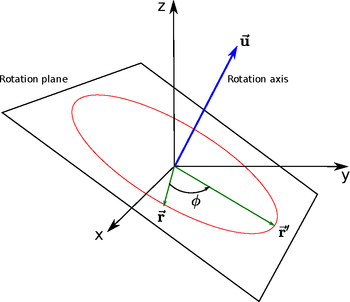Difference between revisions of "Rotations using quaternions"
From Robotics
| Line 4: | Line 4: | ||
Usually rotations are defined by 3 angles, either [[Euler angles|Euler]] or [[Roll-Pitch-Yaw]] angles. So three successive rotations around three different axes lead to a combined rotation, that can be described by a single rotation matrix. Such a combined rotation is equal to a rotation around a certain axis in three-dimensional space about a certain angle. This is shown in the figure on the right. The vector <math>\vec{\mathbf{r}}</math> is rotated such that it results in <math>\vec{\mathbf{r}}'</math>. This could be done by rotating the vector around the z-, the y- and the x-axis successively or by just rotating it around the rotation axis <math>\vec{\mathbf{u}}</math> by <math>\phi</math>. The result is the same as you can see in the example below. | Usually rotations are defined by 3 angles, either [[Euler angles|Euler]] or [[Roll-Pitch-Yaw]] angles. So three successive rotations around three different axes lead to a combined rotation, that can be described by a single rotation matrix. Such a combined rotation is equal to a rotation around a certain axis in three-dimensional space about a certain angle. This is shown in the figure on the right. The vector <math>\vec{\mathbf{r}}</math> is rotated such that it results in <math>\vec{\mathbf{r}}'</math>. This could be done by rotating the vector around the z-, the y- and the x-axis successively or by just rotating it around the rotation axis <math>\vec{\mathbf{u}}</math> by <math>\phi</math>. The result is the same as you can see in the example below. | ||
| − | {{#iDisplay:https://getwww.uni-paderborn.de/dokumente/robotik/media/applets/Quaternion/RPY-Quaternion.html|900px| | + | {{#iDisplay:https://getwww.uni-paderborn.de/dokumente/robotik/media/applets/Quaternion/RPY-Quaternion.html|900px|500px}} |
[[Category:Applet]] | [[Category:Applet]] | ||
Revision as of 16:28, 4 September 2015
| ← Back: Multiplication of quaternions | Overview: Quaternions | Next: Realization of transformations → |
Usually rotations are defined by 3 angles, either Euler or Roll-Pitch-Yaw angles. So three successive rotations around three different axes lead to a combined rotation, that can be described by a single rotation matrix. Such a combined rotation is equal to a rotation around a certain axis in three-dimensional space about a certain angle. This is shown in the figure on the right. The vector  is rotated such that it results in
is rotated such that it results in  . This could be done by rotating the vector around the z-, the y- and the x-axis successively or by just rotating it around the rotation axis
. This could be done by rotating the vector around the z-, the y- and the x-axis successively or by just rotating it around the rotation axis  by
by  . The result is the same as you can see in the example below.
. The result is the same as you can see in the example below.
